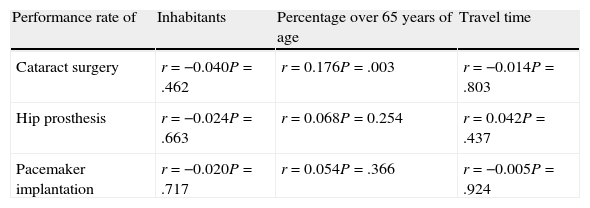Public administrations have to procure equitable care that compensates resistance factors such as communication problems and those arising from aging. Our objective was to analyze the influence of population dispersion and aging on the frequency rate of some common surgical procedures in elderly patients.
Patients and methodsWe used the database of surgical activity of the only hospital in a Spanish province to identify cataract surgeries, hip replacements and pacemaker implants performed during 2010. Using the National Statistics Institute Census, we calculated the rate for each procedure and the proportion of inhabitants over 65 in each municipality. Time needed to access the hospital by road from each municipality was used as a measure of dispersion.
ResultsThe population was distributed into 339 population centers, 90% of which had less than 1000 inhabitants. The worst communicated populations were smaller (r=−0.194; P<.0001) and had a higher proportion of elderly (r=0.406; P<.0001). No relationship was found between the frequentation of the selected interventions and the number of inhabitants or travel time. Similarly, no differences were found when the analysis was done by pooling the population for 30min isochrones. The percentage of those over 65 years was independently associated to the frequency rate of cataract surgery (beta=0.211; P<.001) and showed a trend to increased frequency for the implantation of pacemakers and hip replacements.
ConclusionsOur study shows that, with the current organization of care and in the territory analyzed, neither population dispersion nor aging seems to reduce frequentation of several interventions typical of the elderly population.
Las administraciones han de procurar asistencia equitativa que compense los factores de resistencia, tales como las dificultades de comunicación y las derivadas del envejecimiento. Nuestro objetivo fue analizar la influencia de la dispersión y del envejecimiento de la población, sobre la tasa de realización de algunos procedimientos quirúrgicos comunes en pacientes ancianos.
Población y métodosSe utilizó la base de datos de la actividad quirúrgica del único hospital público de una provincia española para identificar las intervenciones de cataratas, cadera e implantes de marcapasos efectuadas durante el año 2010. Se calculó la tasa de realización de cada procedimiento, y la proporción de mayores de 65 años en cada municipio en función del censo del Instituto Nacional de Estadística. Como medida de dispersión se analizó el tiempo de acceso al hospital.
ResultadosLa población se distribuía en 339 núcleos de población, el 90% menores de 1.000 habitantes. Las poblaciones peor comunicadas eran menores (r=-0,194; p<0,0001)y tenían una proporción mayor de ancianos (r=0,406; p<0,0001). No se identificó relación entre la frecuentación de las intervenciones y el número de habitantes o el tiempo de desplazamiento. Cuando se analizó la población agrupada en isocronas de 30min tampoco se encontraron diferencias. El porcentaje de mayores de 65 años se asoció de forma independiente a la frecuentación de la catarata (beta=0,211; p<0,001), y mostró tendencia a una mayor frecuentación para intervenciones de marcapasos y cadera.
ConclusionesCon la actual organización de la asistencia, ni la dispersión ni el envejecimiento parecen reducir la frecuentación de intervenciones típicas de población anciana en el territorio analizado.
Article
Diríjase desde aquí a la web de la >>>FESEMI<<< e inicie sesión mediante el formulario que se encuentra en la barra superior, pulsando sobre el candado.

Una vez autentificado, en la misma web de FESEMI, en el menú superior, elija la opción deseada.

>>>FESEMI<<<









